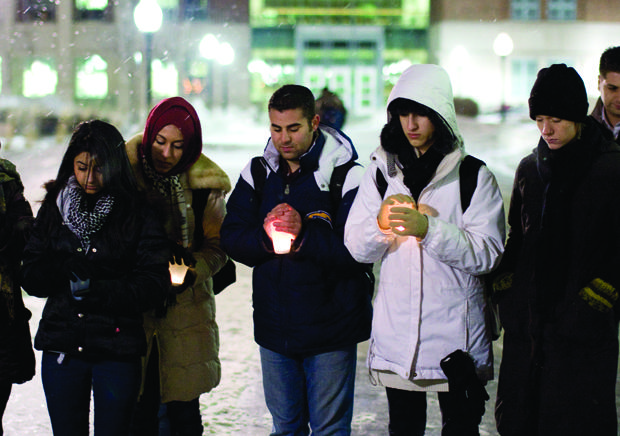Cali Owings, MNDaily, 26 January 2010
Al-Madinah Cultural Center and the Break the Bonds at the University of Minnesota student group s are hosting “Gaza Week” events this week to raise awareness of the Israeli occupation a year after the invasion of the northern Gaza Strip.
Beginning with a body count simulation and candlelight vigil Monday outside of Coffman Union, this week’s activities will include a Wednesday panel discussion and a screening of a documentary.
“We want a good dialogue,” said Fuad Hannon , a second-year finance major and Al-Madinah president. Hannon said he wants to bring to light a struggle he said many people only have a vague idea about.
Break the Bonds contacted Al-Madinah to organize these events. Hannon said the two groups shared a mutual interest educating students about a perspective they claim is not covered by mainstream media.
Minnesota Break the Bonds is a campaign against the Israeli occupation in Gaza. Rachel Orville , a graduate student at the Humphrey Institute of Public Affairs, said the goal is to educate students and Minnesota residents because their tax dollars support the occupation.
Orville said Break the Bonds is a group of “Americans from different religious bases who have a common understanding of the political conflict.”
Despite their intentions to educate and create an open dialogue, Hannon admits that controversy will probably arise.
“It’s bound to make certain people uncomfortable,” he said.
The project has certainly left an impression on junior applied economics major Max Dougherty .
After seeing the body count simulation, which claimed a 100-1 ratio of dead Palestinians to Israelis during the Gaza War of December 2008 and January 2009 , Dougherty said, “It puts things into perspective … it makes what you read here jump off the page.”
However, Samantha Bass , a University senior working with the Committee for Accuracy in Middle East Reporting in America , is skeptical of a 100-1 body count being used by Break the Bonds.
Bass compared the conflict to the story of David and Goliath.
Americans see Israel as Goliath because it’s the stronger, wealthier power and the Palestinian people as David, Bass said.
“Israel is defending itself [from Palestinian missiles] and that’s sometimes lost in the media,” she said.
According to a U.N.-commissioned fact-finding mission, Palestinian groups estimated that more than 1,400 Palestinians were killed in the Gaza War, while the Israeli Army claimed a death toll of 1,166 Palestinians. The Israeli Foreign Ministry reported that 13 Israelis were killed during the conflict.
Monday night, the Gaza Week participants huddled around the simulation for the candlelight vigil in the snow and shared a moment of silence.
Amber Michel , a student from St. Cloud State University who first held the body count simulation, opened the vigil with words she attributed to the first Israeli Prime minister David Ben-Gurion , “The old will die, and the young will forget.”
“We are here because we do not forget,” Michel said.
Though the object of Gaza Week is to encourage discourse and different perspectives, Senna El Bakri , a second-year PSEO student and Al-Madinah secretary, said it’s also meant to stir controversy.
When asked about alienating Jewish students, Hannon and Orville reiterated that the occupation is a political conflict, not a religious one.
There was a frustrated mood at Hillel Jewish Student Center over Gaza Week.
Phil Meyer , a Jewish second-year and applied economics major who has visited Israel three times, stated the demonstration was “a little disheartening.”
“If America did not support Israel, it might not exist anymore,” he said.
Gaza Week will conclude with a lecture from Hatem Bazian, a University of California-Berkeley professor who many consider to be a highly controversial speaker.

